Cyclamen look difficult, but are easier to care for than you might think. But, since their growing season is different than it is for other plants, many people struggle to keep them alive. Don’t worry, in this detailed guide I will show you all you need to know so they will thrive for years to come.
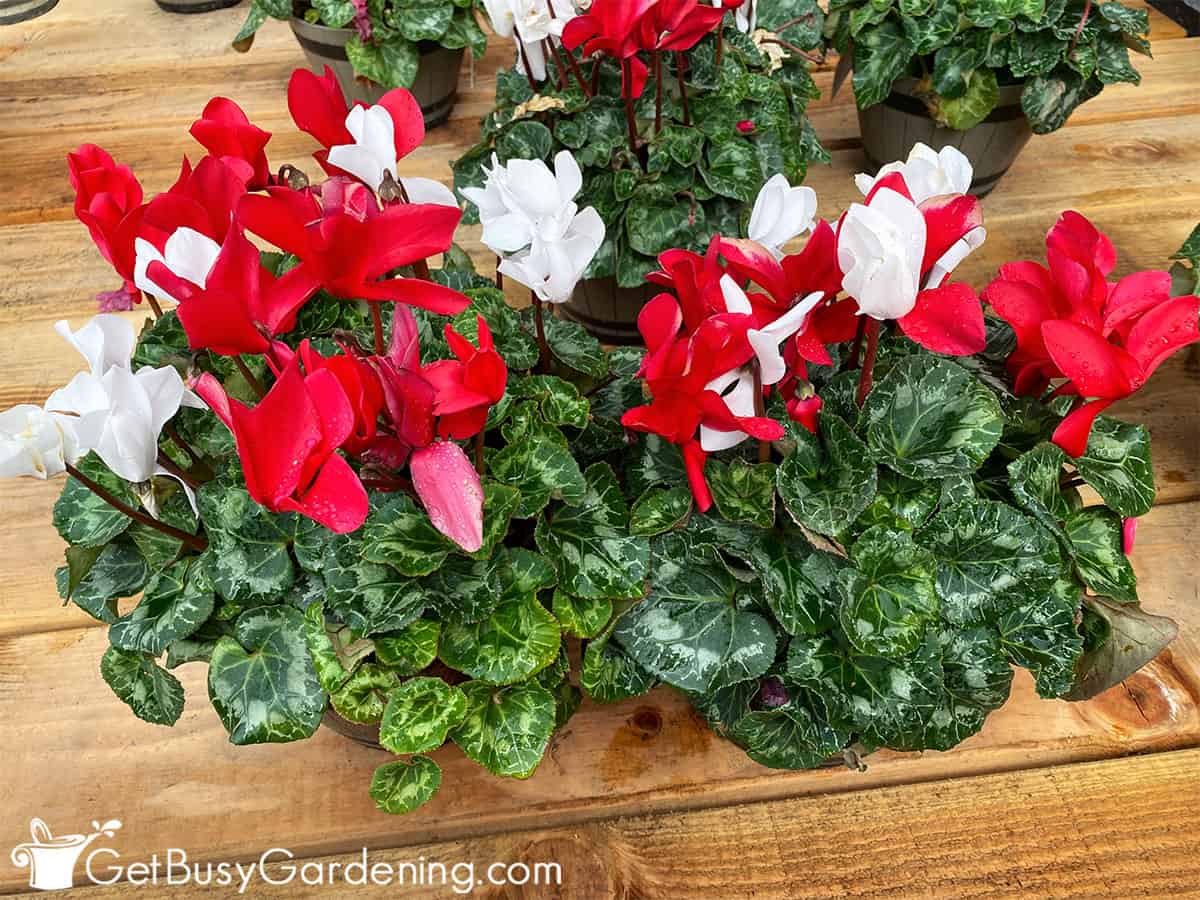
Though they have a reputation for being fussy, cyclamen plants are actually surprisingly easy to grow once you know their care requirements.
They are much tougher and hardier than they look, and do equally well in the garden as they do indoors. Plus they come in a wide variety of shapes, sizes, and colors, which makes them fun to collect too.
The good news is that, with the right cyclamen care, you can keep your plant for decades, and get it to bloom over and over again.
Continue reading to learn all you need to know about how to grow cyclamen in this detailed guide. Below you’ll find details about watering, fertilizer, soil, humidity, flowering, light, and much more.
Cyclamen Quick Care Overview
| Scientific name: | Cyclamen |
| Classification: | Tropical plant |
| Common names: | Cyclamen, others vary by variety |
| Hardiness: | Ranges fro zones 3-11, but varies by type |
| Temperature: | 50-70°F |
| Flowers: | Several colors, blooms in late winter/early spring |
| Light: | Full to partial shade, bright light indoors |
| Water: | Allow soil to dry between waterings, do not overwater |
| Humidity: | High |
| Fertilizer: | General purpose plant food fall-spring |
| Soil: | Fast-draining, fertile soil |
| Common pests: | Spider mites, aphids, thrips, mealy bugs |
Information About Cyclamen Plants
Cyclamen, which is also their common name, is a genus of perennials that are native to the Mediterranean and other parts of Europe.
There are only 23 different species, but they come in a wide range of colors, sizes, and hardiness.
They’re also very durable, and can grow either indoors or outside, so you can enjoy them in your home and garden.
Since they are winter flowering plants, they’re very popular gifts around the holidays, especially for Christmas and Valentines Day. The bright, cheery flowers last a long time, and they are gorgeous.

Cyclamen Life Cycle
Cyclamens have an opposite growing season than most plants. Since they bloom in the winter, it means that they thrive during the cooler months of the year, and go dormant in the heat of the summer.
That’s why they’re such popular gift plants around the holidays, and the reason they made my list of the top flowering houseplants.
However, it’s also the main cause for confusion on how to successfully grow them.
The biggest mistake people make with cyclamen care is trying to force them to grow year round. Most people don’t realize they need a period of rest in order to thrive.
Different Cyclamen Varieties
There are tons of beautiful cyclamen varieties and hybrids to choose from, and they all share similar care requirements. So whichever species you choose, you can’t go wrong. Here are some popular ones.
- Cyclamen persicum – Also called florist cyclamen, this is one of the most common varieties you can grow, but also the least cold hardy.
- Cyclamen purpurascens – The hardiest type of all, these can survive the winters outdoors all the way down to zone 3. But they hate the heat, and won’t do well in warmer climates.
- Cyclamen hederifolium – Another cold hardy variety, but only down to zone 5 outdoors. It blooms profusely in late winter/early spring, with lovely pink-purple flowers and gray-green mottled leaves.
- Cyclamen coum – This specimen has rounded dark green leaves which are marbled with silver, and the flowers can be anywhere from white, pink, or red.
Flowers
In nature, cyclamens flower during the winter, and go completely dormant in the summer. Indoors they follow a similar pattern.
Once open, the small fragrant blossoms dangle at the tops of tall skinny stems, which makes them appear to float above above the gorgeous heart shaped foliage.
They can be single or double, and some of them have ruffled edges, while others are rounded.
The delicate flowers come in a wide range of colors too, and can be anywhere from light, dark, or hot pink, white, red, purple, coral, and some even have white tips or margins.
Related Post: What To Do With Cyclamen After Flowering
Toxicity
A common question I get asked is: “are cyclamen plants poisonous?”. The short answer is yes. According to the ASPCA website the tubers are toxic to both cats and dogs when ingested.
So, if you have any pets or young children running around, it’s best to keep this one out of reach, just in case.
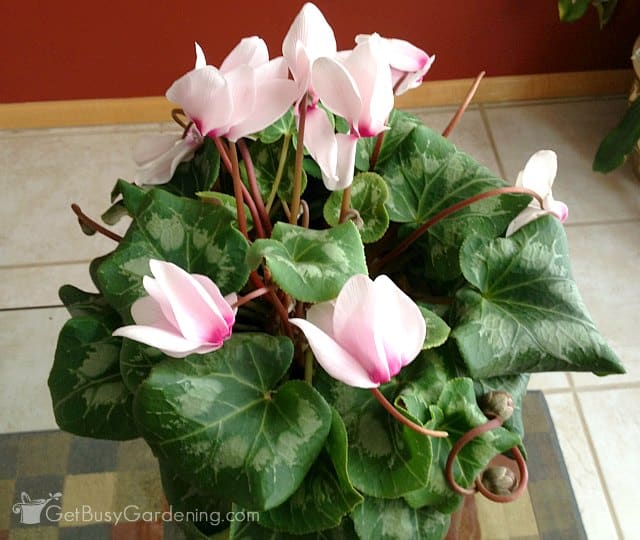
How To Care For Cyclamen
Before we dive into the detailed care requirements for cyclamen, first we need to discuss where to grow them. Choosing a good location is the first step for long-lasting health.
Hardiness
Though cyclamen are most commonly grown as houseplants, you might be surprised to learn that they’re perennials. They look tropical, but actually prefer cooler weather over heat.
Depending on the species, the hardiness can range anywhere from zones 3-11. That means that most gardeners can actually grow them outside in their garden. Woohoo!
However, it’s important to know which species you have, because some will only survive in warmer regions, while others require cold climates.
Where To Grow Cyclamens
Whether yours is in a pot or the ground, the ideal location for growing cyclamen is an area that gets partial shade or filtered sunlight, and stays cool during the winter.
Indoors they will do great in a bright room with indirect sunlight, or in an east or west facing window.
Outside they prefer a dry shady spot where they’ll be protected from the hot afternoon rays.
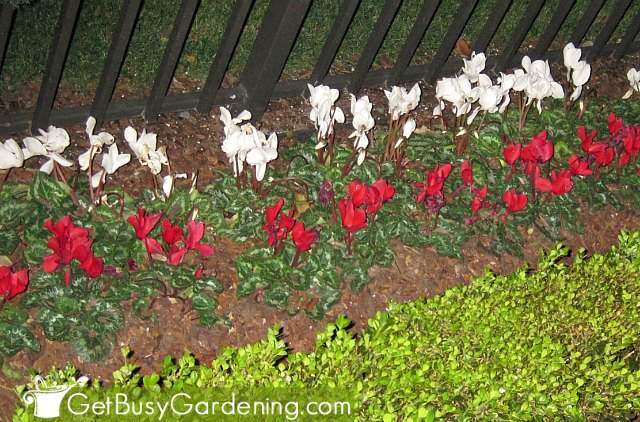
Cyclamen Plant Care & Growing Instructions
Now that you know where to grow them, it’s time to talk about the specifics of cyclamen plant care. The tips below will ensure you will be able to keep yours happy and healthy.
Cyclamen Temperature Tolerance
Cyclamens are very fussy about the temperature. They like to be kept cool during their active growing season (fall through spring). If they get too hot, it will force an early dormancy.
Indoors, keep them in a room where the temperature is between 50-70°F. The cooler they’re kept, the longer the flowers will last too.
They’re also sensitive to drafts, so avoid areas where hot or cold air blows (like near heat vents or drafty windows).
Providing the ideal cyclamen growing conditions outdoors is pretty easy during the winter, since it’s naturally cooler. Just protect them from the heat of the sun.
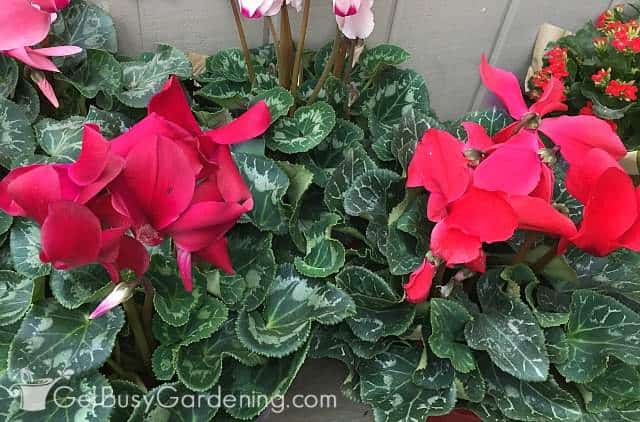
Watering
Proper cyclamen watering is a critical part of their care, and another thing that is a bit different than most plants.
Like African violets, they don’t like getting their leaves and stems wet. So it’s best to water them from the bottom, rather than over the top.
They like to stay evenly moist during their active growth period, and then dry out during summer. Consistent overwatering will kill them.
So allow yours to dry slightly between waterings, but never completely bone-dry. If you’re not sure how to keep them properly watered, I recommend getting a moisture gauge to help you out.
Using special pot that’s self-watering is perfect for growing cyclamen plants, and would be a great help to protect against overwatering.
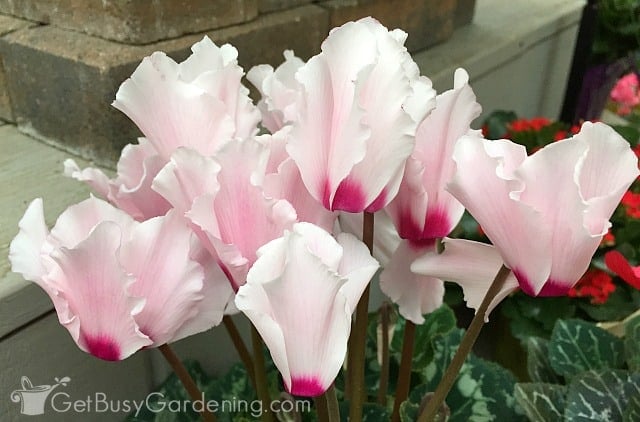
Humidity Requirements
Another important piece of successful cyclamen plant care is humidity. They like a lot of humidity, and this is especially important during the winter months.
To help increase the level around your cyclamen, you can run a humidifier nearby. You could also try putting it on top of a pebble tray filled with water.
To help you maintain the proper amount, try keeping an indoor humidity monitor near them to make sure the air doesn’t get too dry.
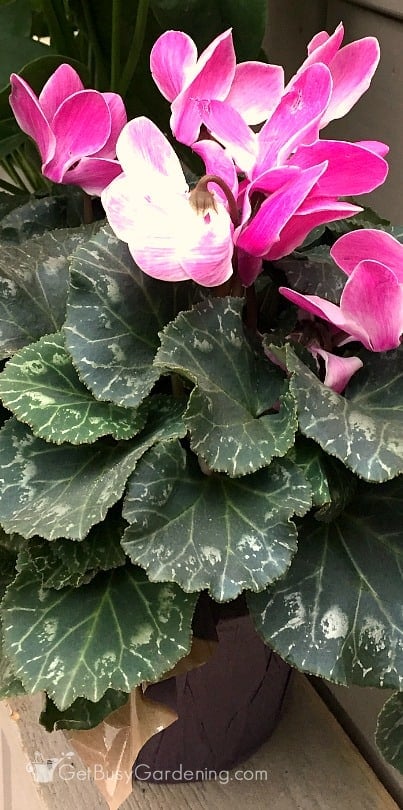
Light
Cyclamen plants like bright light, but they don’t like it hot, so take care to keep them out of the sun. Direct sunlight is too intense for them anyway, and can burn the leaves.
However, if they don’t get enough light, especially indoors, they can get tall and leggy. So find a spot where they’ll receive morning and evening sun, but be shaded from the strong afternoon rays.
A window with filtered light indoors, or a partial shade location outdoors are the best choices.
Soil
General purpose potting soil will usually work just fine for growing cyclamens, as long as it doesn’t hold too much moisture. If you tend to overwater, then use a fast draining mix instead.
You can always amend regular potting medium or clay garden soil with perlite or pumice and sand to give it better drainage.
Repotting
If your cyclamen has outgrown its container, you can repot it into a larger one. The best time for repotting is while they’re dormant.
Make sure to plant your cyclamen in the new pot at the same depth it was in the old one, and that it has adequate drainage.
Don’t bury the tubers too deep, they should be kept slightly above the soil line.
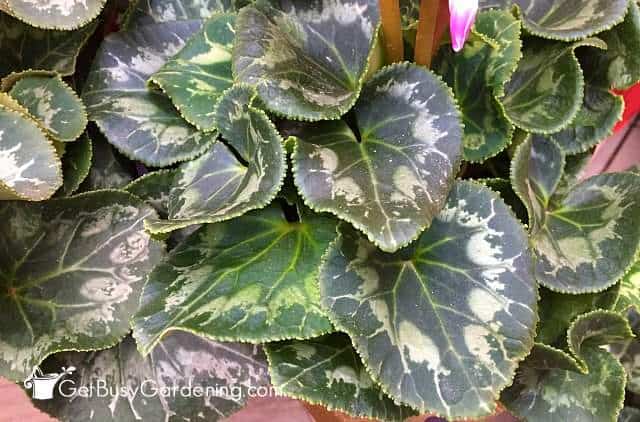
Fertilizer
You can fertilize your cyclamen using a weak half dose of liquid plant food every 2-4 weeks while it’s actively growing and blooming. Stop once the flowers begin to fade.
When you bring it out of dormancy, begin feeding again when it starts to put on new growth. A good rule of thumb is to only feed them while they have leaves.
They are very sensitive to chemicals, which can cause major damage. So I highly recommend using an organic option.
Compost tea, which you can get in liquid form or buy tea bags and brew your own, is a great choice. An organic flower fertilizer also works well, or use a general purpose one.
Pruning
Regular pruning is not a necessary part of cyclamen care. Normally the only time you’ll have to worry about it is as the flowers and foliage begin to fade and die back.
Simply snip off any dead or dying leaves and bloom stems at the base as needed using precision pruners. Once it’s completely died back, cut everything down to the soil line.
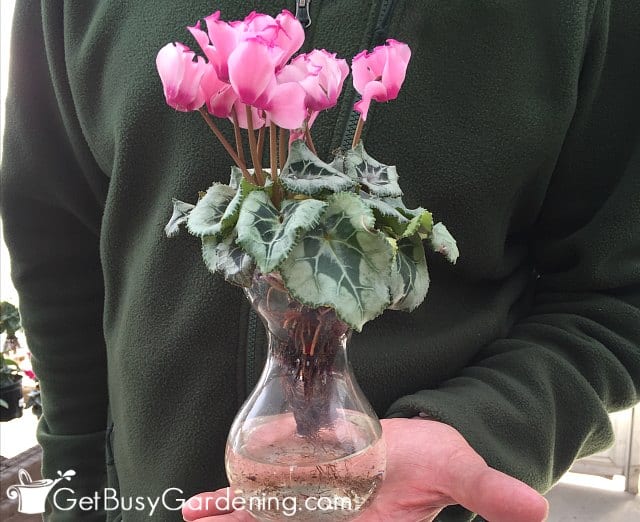
Pest Control Tips
Pests are rarely an issue with healthy cyclamen plants, but spider mites, aphids, thrips, or mealy bugs can sometimes attack them.
You can gently wipe the leaves with a damp cloth or one soaked with a natural insecticidal soap the help get rid of bugs.
Or spot-treat them by dabbing the insects with a cotton swab soaked in rubbing alcohol.
The leaves can be sensitive to sprays though. So to avoid damage, test them on one leaf for a few days before treating the whole plant, and don’t use any chemical products.
Dormancy
As I’ve mentioned before, cyclamen needs a period of dormancy as part of their annual care routine.
The catch is that it normally occurs during the summer, which is opposite than for most other plants.
Their natural cycle is that once the flowers fade, the leaves will start to die back and drop off.
Eventually the plant will die all the way back to the soil, and officially begin its rest period.
Unfortunately when this happens, most people think it’s dying or that they killed it, so they’ll throw it out.
However, this is a normal part of their life cycle, and just like amaryllis, they need it in order to bloom again.
So don’t toss it out when it starts to die back! With the proper care, you will be able to get your cyclamen to bloom again every year. Learn all about their dormancy and how to revive them here.
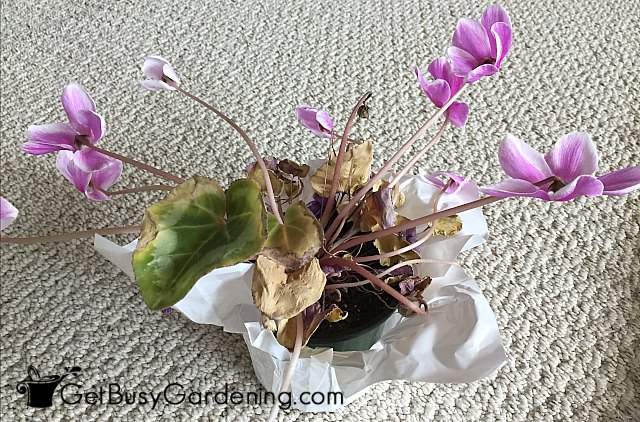
Cyclamen Propagation Tips
Cyclamen plants can easily be propagated by dividing the tubers and potting them into their own container. Each individual tuber will become a new plant.
They can also be grown from seed, and many times will sow themselves in the garden. But it can take a year or more before the new babies start to bloom.
So this method is definitely much slower than splitting mature ones.
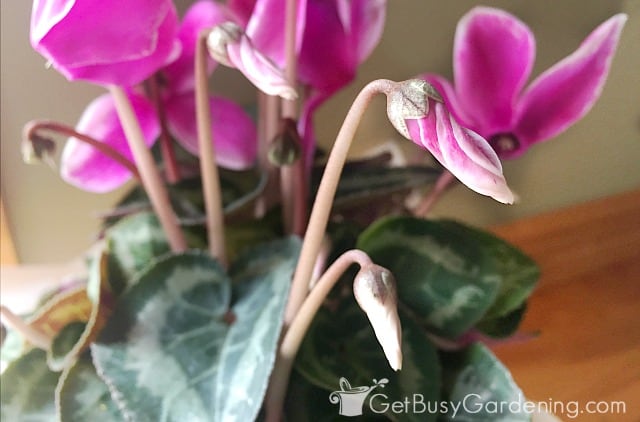
Troubleshooting Common Cyclamen Care Problems
In this section, I’ll help you troubleshoot some of the most common cyclamen plant care problems. These tips will help you get yours back to health in no time.
Yellow Leaves
When the leaves start turning yellow, it can be a sign that your cyclamen is getting too hot. Move it to a cooler location, and keep it out of the direct sunlight.
If it has just finished blooming, then it’s probably going dormant, which is totally normal behavior. Learn all about the possible causes and how to fix yellow leaves here.
Flowers Drooping
Droopy leaves and flowers are usually caused by improper watering. Check the moisture level to make sure it’s not too wet or dry.
It’s also normal for the blooms to start drooping as they fade. In that case, cut them off at the base to help the others last longer.
Not Flowering
If your cyclamen is not flowering, that usually means it didn’t get a proper rest period. But it can also be caused by lack of nutrients, or the tubers were planted too deep.
First, ensure they get 2-3 months of full dormancy during the summer. If that’s not the problem, try giving them a dose of plant food during their active growth period.
Otherwise, repot or transplant them, ensuring the tops of the tubers stay slightly above the soil.
Foliage Looks Dirty Or Deformed
If the leaves or flowers look like they’re dirty, faded, or deformed, then it’s probably caused by bugs.
Gently wipe the leaves with a damp cloth soaked in water or insecticidal soap, but never spray anything on them.
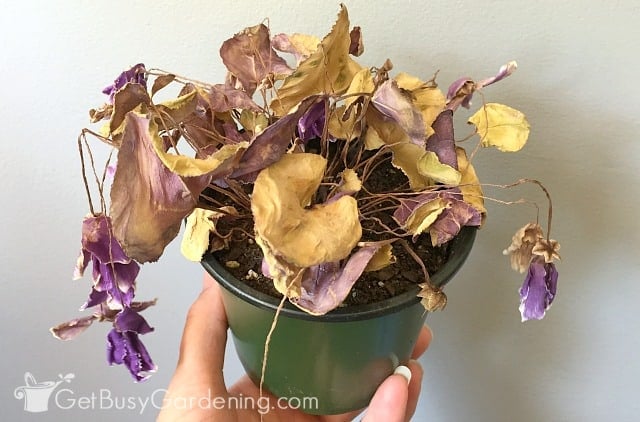
Cyclamen Care FAQs
In this section I’ll answer some of the most frequently asked questions about cyclamen care. If you can’t find yours here, then leave a comment below.
Do cyclamens grow back every year?
Yes, with the proper care, cyclamens will grow back every year indoors. Whether they will grow back outdoors depends on the hardiness of the specific variety you have, as well as your climate.
How long do cyclamen plants last?
On average, cyclamen flowers last for as long as 6-8 weeks. But some can bloom for up to 3 months in the ideal conditions. The plants themselves can live for decades.
Are cyclamens indoor or outdoor plants?
Cyclamens can be either indoor or outdoor plants. They will thrive as houseplants as long as they stay cool, and will survive outside in the proper climate.
Do cyclamens like shade or sun?
Cyclamens like shade, as the full sun is too hot for them. Indoors give them bright, indirect, or filtered sunlight from an east or west facing window.
Can cyclamen be planted outside?
Yes, cyclamens can be planted outside and can grow there year round as long as the variety you have is hardy in your zone. Plant them in a full or partial shade location where they’ll be protected from the hot afternoon sun.
Where do cyclamen grow best?
Cyclamen grow best in a humid, shady location with free-draining soil where they will stay cool, especially during the winter.
With proper cyclamen plant care, these beauties will bloom every year around Christmas time. Now that you know how to grow them, you’ll be able to enjoy the flowers for many years to come.
If you want to learn all there is to know about maintaining healthy indoor plants, then you need my Houseplant Care eBook. It will show you everything you need to know about how to keep every plant in your home thriving. Download your copy now!
More Holiday Plant Care Guides
- How To Care For Poinsettia Plants
- How To Care For A Thanksgiving Cactus (Schlumbergera truncata)
- How To Care For A Holiday Cactus Plus Growing Tips
- How To Care For An Easter Cactus Plant (Schlumbergera gaertneri)
- How To Care For A Christmas Cactus Plant (Schlumbergera buckleyi)
Share you cyclamen care tips in the comments section below.
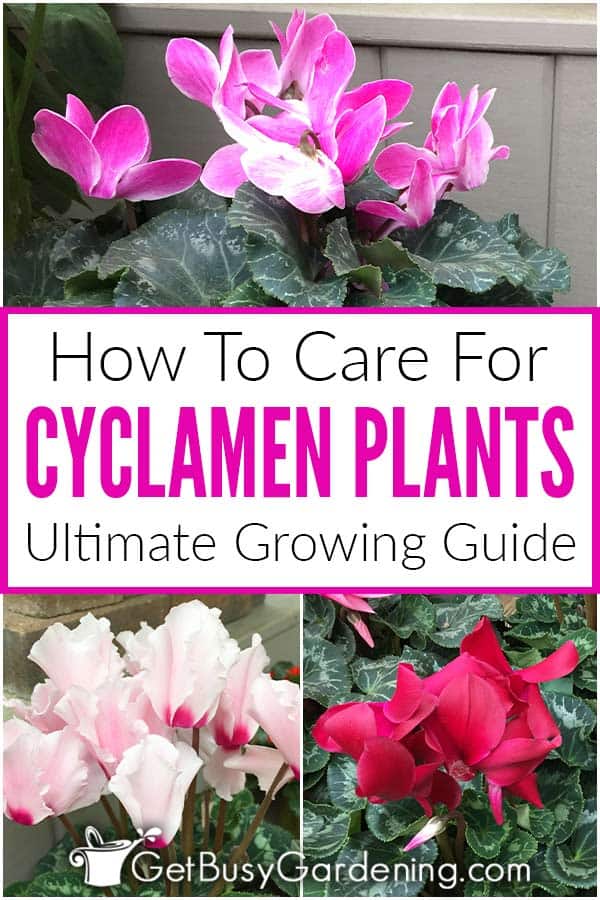
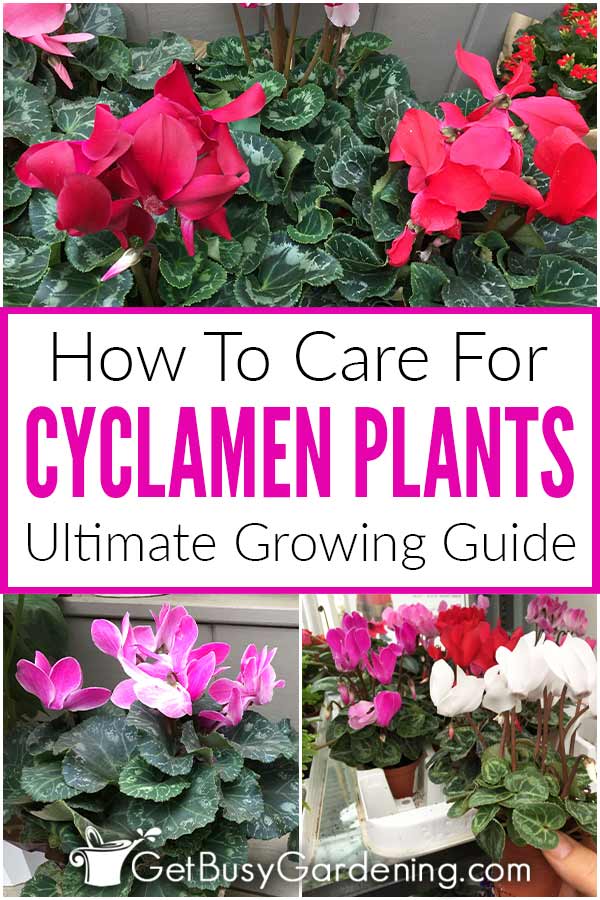
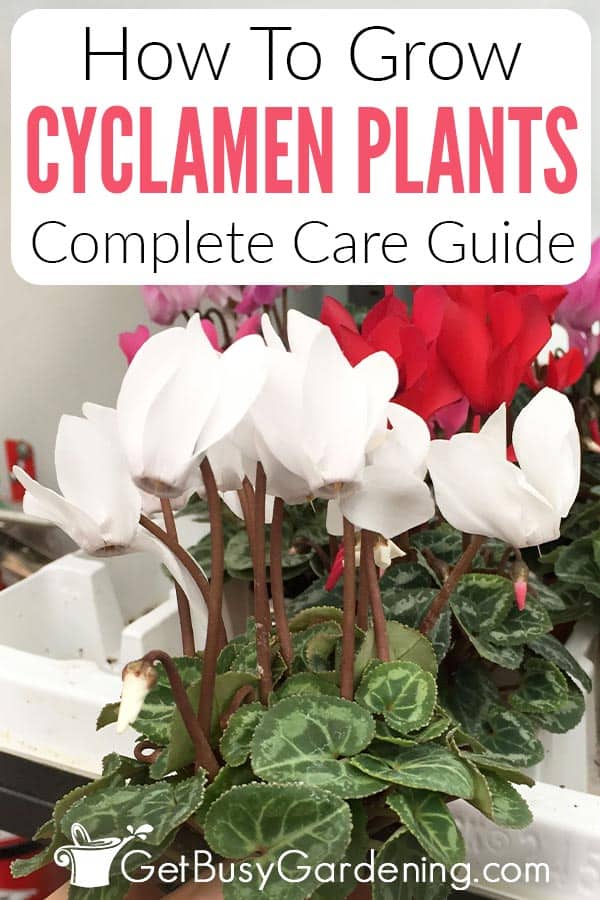
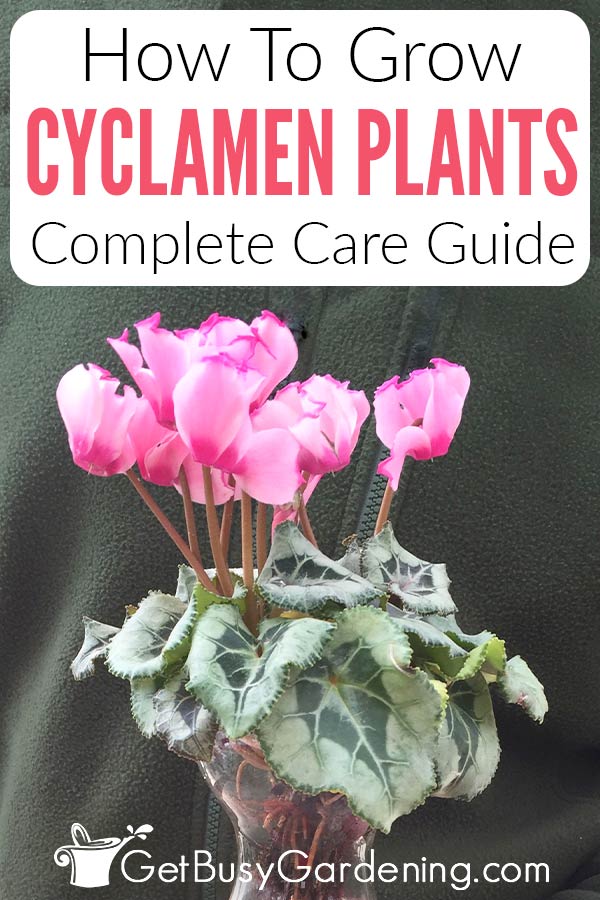
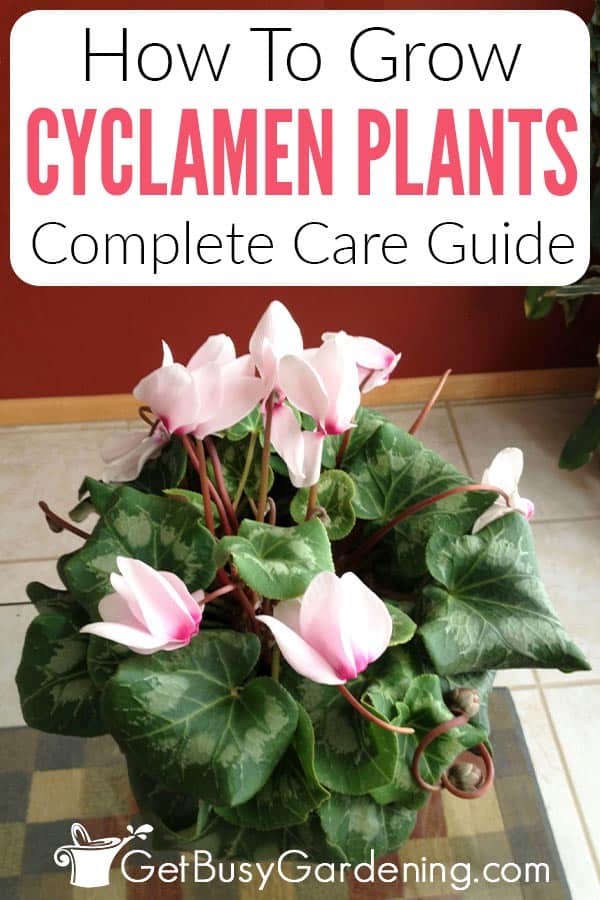
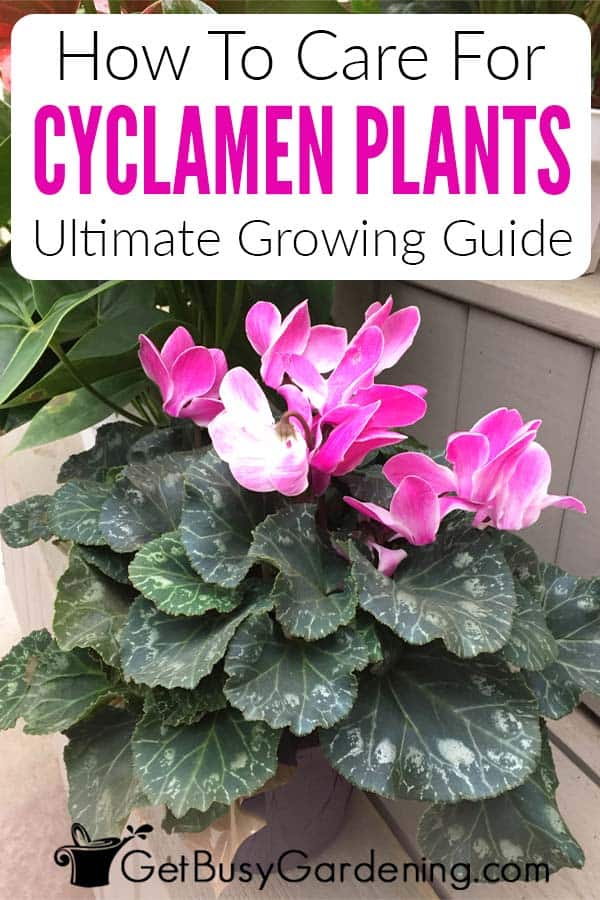



Florence says
I just bought a Cyclamen from a greenhouse. I live in Edmonton, Alberta, Canada. I will be keeping mine as a houseplant. It is mid August right now and is blooming and has more buds on it. My question is…has it been forced to bloom or am I confused. Does it bloom in summer here or should it be blooming in winter? We were visiting Australia a few years ago in October (their spring) and there were cyclamen everywhere. So, I would guess that they do winter and spring there and maybe fall and winter here? I want some expectation of how long they may continue to bloom. Thanks for dealing with my confusion.
Amy Andrychowicz says
If you just bought it then yes, the cyclamen was probably forced to bloom out of season. That’s ok, it will go back to it’s natural cycle of blooming in the winter and going dormant in summer after a year or two.
Deborah Wales says
Hi my name is Deborah and I live in New Zealand. I have some cyclamen that become dormant in summer and I have some that grow and bloom all summer and then continue to do so in winter. One of my cyclamen has been doing this for 5 years, ever since I bought it. What is going on?
Amy Andrychowicz says
I’ve heard of some varieties that can bloom all year round, and never go dormant, so you probably have one of those. There are so many different hybrids of cyclamens these days, it’s impossible to keep track, LOL! Whatever it is, keep doing what you’re doing, because obviously they are happy with your magic touch! 😉
Violet says
I bought a mini cyclamen in late summer. The flowers are beginning to fall of, but it still has three left. I would like to know how much time the last before they go dormant.
Thank you very much.
Amy Andrychowicz says
Since it was blooming when you got it during the summer, your cyclamen was probably forced to bloom by the grower, and now it’s confused, LOL! When they force plants to flower outside of their normal bloom cycle like that, it’s hard to predict exactly how they will behave. It could just be dropping flowers from the shock of the move to a new environment (your home), or it could be starting to go dormant. Until you can tell for sure, I would just keep an eye on it to see if it recovers or continues to show signs of dormancy, and care for it as such. Since yours was forced to bloom out of season, it may take a year or two for it to get back on a normal schedule.
Jean says
I have a cyclemen plant and it is now 30 years old,Is that the normal time that they survive ?
I thought it had died on me but low and behold it has 3 beautiful blooms again this year.
I would love to know if they normally live that long.
Amy Andrychowicz says
Wow, congratulations on having your cyclamen for so many years! Sounds like you have the right touch with caring for them, fantastic! Oh boy, I have no idea how old cyclamen plants can get, or how many years they can live, and I’m sure it depends on the species. But, just like any plant, they can live for decades with the right care. However, since they are normally grown as gift plants, most people discard them after they go dormant because they think they killed it. For that reason alone, the majority of cyclamen plants don’t live nearly as long as yours has. Keep doing what you’re doing, and enjoy your beautiful plant!
Sheryl says
I have a cyclamen plant with beautiful leaves but no flowers….what am I doing wrong?
Amy Andrychowicz says
Cyclamen plants need a period of dormancy during the summer in order to rebloom. Check out the section above titled “Cyclamen Flowering Season & Dormancy” for details and the steps for reblooming.
Catherine says
My cyclamen plant is very leggy. What do I need to do for it?
Amy Andrychowicz says
You can try adding a grow light to keep them from getting leggy. Cyclamens can also grow leggy when they are pot-bound, so you could try repotting it once it goes dormant, or in early spring.
philip Edwards says
My cyclamen drooped within a week of buying it, i obviously mistreated it. My question is…now that the foliage and dead flowers have come off. is there any point in keeping it?
Amy Andrychowicz says
Bummer! The growers force cyclamen to bloom using chemicals and warm/humid greenhouses, and sometimes the shock of moving to a normal home environment can be too much for them. If it hasn’t been too long, you could see if the store would exchange it for a new one. Otherwise, you could try keeping it through dormancy, and see if it will wake up again. See the section above titled “What To Do With Cyclamen After Flowering” for details. Good luck!
Rose says
i have a 10yr old cyclamen and it blooms every year, however bought 3 more 2 years ago and they only produce leaves and no flowers is there a type of cyclamen that just doesnt come back in the following years? I spoke to a guy who cultivates cyclamen on youtube and he said it was a certain type of cyclamen and it will never bloom again just leaves? so it’s certainly not dead, so is there something i could do to get it flowering again?
Amy Andrychowicz says
Humm… I’m not sure. I’ve never heard of cyclamen plants that will never rebloom. There are TONS of different varieties though, so I guess it’s possible. But usually, if it blooms once, that means it’s possible to get it to bloom again. Growers use lots of chemicals to force plants to flower out of season, and it can take a few years for some types to bounce back to their normal lifecycle. So, I would keep caring for them like you do with your other cyclamen, and eventually (hopefully) they will rebloom.
Irene says
Wondering why the tiny little regrowth flowers are dying off before they get taller than 5cm.
Amy Andrychowicz says
Humm… it’s really hard to say without more information. Is your cyclamen a brand new plant, or have you had it for years? Is it going dormant, or just coming out of dormancy. If you could give me more details, that would be helpful.